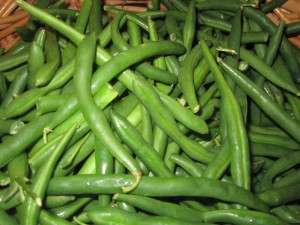Freezing Green Beans
 With so many vegetables and fruits in abundance now I think its important to consider putting some away for winter. I had a request from a friend to post this info. She wants to have green beans from her garden at her Thanksgiving dinner. Not a problem at all. You could can green beans, lots of people do. Canning them does require a pressure canner, which my friend doesn’t have. You could also pickle them or dehydrate them, but for the green bean dish my friend wants I think freezing them is the way to go.
With so many vegetables and fruits in abundance now I think its important to consider putting some away for winter. I had a request from a friend to post this info. She wants to have green beans from her garden at her Thanksgiving dinner. Not a problem at all. You could can green beans, lots of people do. Canning them does require a pressure canner, which my friend doesn’t have. You could also pickle them or dehydrate them, but for the green bean dish my friend wants I think freezing them is the way to go.
Unlike canning, safety is not the primary concern when freezing. Quality is, however, and by following a few steps you can enjoy your harvest all year round.
To freeze green beans start by washing the beans and trimming off the ends. You can freeze them whole or cut. Beans are best when blanched in boiling water before freezing. Have a large pot of water boiling and a bowl of ice water ready. Place prepped beans in the boiling water for 3 minutes. Remove with a slotted spoon and place in the ice water to cool down. If you are blanching a lot of beans do them in batches. Placing too many will bring the temp of the boiling water down too much. Once beans are cooled down drain them and place in freezer bags or containers, label and date then place in freezer. When ready to use them take from the freezer and place beans in boiling water until tender- about 5 minutes.
Advantages of freezing are that you don’t need to buy a canner or worry about spoilage. You will, however, need freezer space and freezer containers to prevent freezer burn. And of course in the event of a prolonged power outage you could lose it all. I think some foods are better when frozen than canned, like green beans which must be processed for a very long time when canned.
Always label what you freeze and date it. It’s amazing how time flies. While food remains safe for ages in the freezer it is best to use most home-frozen foods within a year of freezing.
Some foods need to be blanched before freezing. Blanching is simply putting the food in boiling water steaming for a few minutes and then plunging the food into ice water to stop the cooking. Blanching kills surface bacteria and also causes the produce to wilt, thus making it easier to pack. Blanching also stops the action of ripening enzymes, thus keeping that just-picked taste. The issue with fruits and vegetables is whether to blanch before freezing or not. As a rule, fruits are not blanched and most vegetables are. Peppers and onions can be frozen without blanching.
The biggest problem with home freezing is that most home freezers aren’t cold enough. Refrigerator-freezer combinations tend to be warmer than separate freezers. To have the best results foods should be kept at -20 degrees. If you’re lucky you might have a freezer that is as cold as -10 degrees. Some are at warm as 10 above zero. Fine for making ice cubes, but too cold for long term freezing. Get a freezer thermometer and keep track. The warmer the freezer the shorter you should be keeping foods frozen.




